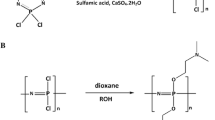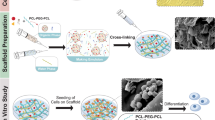Abstract
Biomedical scaffolds should be designed with highly porous three-dimensional (3D) structures that have mechanical properties similar to the replaced tissue, biocompatible properties, and biodegradability. Here, we propose a new composite composed of solid free-form fabricated polycaprolactone (PCL), bone morphogenic protein (BMP-2) or bone formation peptide (BFP-1), and alginate for bone tissue regeneration. In this study, PCL was used as a mechanical supporting component to enhance the mechanical properties of the final biocomposite and alginate was used as the deterring material to control the release of BMP-2 and BFP-1. A release test revealed that alginate can act as a good release control material. The in vitro biocompatibilities of the composites were examined using osteoblast-like cells (MG63) and the alkaline phosphatase (ALP) activity and calcium deposition were assessed. The in vitro test results revealed that PCL/BFP-1/Alginate had significantly higher ALP activity and calcium deposition than the PCL/BMP-2/Alginate composite. Based on these findings, release-controlled BFP-1 could be a good growth factor for enhancement of bone tissue growth and the simple-alginate coating method will be a useful tool for fabrication of highly functional biomaterials through release–control supplementation.







Similar content being viewed by others
References
Langer R, Vacanti JP (1993) Tissue engineering. Science 260:920
Karageorgiou V, Kaplan D (2005) Porosity of 3D biomaterial scaffolds and osteogenesis. Biomaterials 26:5474–5491
Betz MW, Yeatts AB, Richbourg WJ, Caccamese JF, Coletti DP, Falco EE, Fisher JP (2010) Macroporous hydrogels upregulate osteogenic signal expression and promote bone regeneration. Biomacromolecules 11:1160–1168
Hing KA, Best SM, Tanner KE, Bonfield W, Revell PA (2004) J Biomed Mater Res 68A:187–200
Whang K, Healy KE, Elenz DR, Nam EK, Tsai DC, Thomas CH, Nuber GW, Glorieux FH, Travers R, Sprague SM (1999) Engineering bone regeneration with bioabsorbable scaffolds with novel microarchitecture. Tissue Eng 5:35–51
Hutmacher DW, Sittinger M, Risbud MV (2004) Scaffold-based tissue engineering: rationale for computer-aided design and solid free-form fabrication systems. Trends Biotechnol 22:354–362
Moroni L, Schotel R, Hamann D, de Wijn JR, van Blitterswijk CA (2008) Adv Funct Mater 18:53–60
Yeo MG, Jung WG, Kim GH (2012) Fabrication, characterisation and biological activity of phlorotannin-conjugated PCL/β-TCP composite scaffolds for bone tissue regeneration. J Mater Chem 22:3568–3577
Lee HJ, Kim GH (2011) Three-dimensional plotted PCL/β-TCP scaffolds coated with a collagen layer: preparation, physical properties and in vitro evaluation for bone tissue regeneration. J Mater Chem 21:6305–6312
Venkatesan J, Qian ZJ, Ryu BM, Kumar NA, Kim SK (2011) Preparation and characterization of carbon nanotube-grafted-chitosan—natural hydroxyapatite composite for bone tissue engineering. Carbohydr Polym 83:569–577
Wutticharoenmongkol P, Sanchavanakit N, Pavasant P, Supaphol P (2006) Novel bone scaffolds of electrospun polycaprolactone fibers filled with nanoparticles. J Nanosci Nanotechnol 6:514–522
Fujihara K, Kotaki MS, Ramakrishna S (2005) Guided bone regeneration membrane made of polycaprolactone/calcium carbonate composite nano-fibers. Biomaterials 26:4139–4147
Susan L, Wang W, Uo W, Ohkawa S, Akasaka T, Tamura K, Cui F, Watari F (2005) A three-layered nano-carbonated hydroxyapatite/collagen/PLGA composite membrane for guided tissue regeneration. Biomaterials 26:7564–7571
Chew SY, Wen J, Yim EKF, Leong KW (2005) Sustained release of proteins from electrospun biodegradable fibers. Biomacromoecules 6:2017–2024
David L, Feige JJ, Bailly S (2009) Emerging role of bone morphogenetic proteins in angiogenesis. Cytokine Growth Factor Rev 20:203–212
Pountos I, Georgouli T, Henshaw K, Bird H, Jones E, Giannoudis PV (2010) The effect of bone morphogenetic protein-2, bone morphogenetic protein-7, parathyroid hormone, and platelet-derived growth factor on the proliferation and osteogenic differentiation of mesenchymal stem cells derived from osteoporotic bone. J Orthop Trauma 24:552–556
Kann S, Chiu R, Ma T, Goodman SB (2010) OP-1 (BMP-7) stimulates osteoprogenitor cell differentiation in the presence of polymethylmethacrylate particles. J Biomed Mater Res A 94:485–488
Kim HK, Kim JH, Park DS, Park KS, Kang SS, Lee JS, Jeong MH, Yoon TR (2012) Osteogenesis induced by a bone forming peptide from the prodomain region of BMP-7. Biomaterials 33:7057–7063
Becker TA, Kipke DR, Brandon T (2001) Calcium alginate gel: a biocompatible and mechanically stable polymer for endovascular embolization. J Biomed Mater Res 54:76–86
Van Tienen TG, Heijkants RGJC, Buma P, De Groot JH, Pennings AJ, Veth RPH (2002) Tissue ingrowth and degradation of two biodegradable porous polymers with different porosities and pore sizes. Biomaterials 23:1731–1738
Yang S, Leong KF, Du Z, Chua CK (2001) The design of scaffolds for use in tissue engineering. Part I. Traditional factors. Tissue Eng 7:679–689
Zeltinger J, Sherwood JK, Graham DA, Mueller R, Griffith LG (2001) Effect of pore size and void fraction on cellular adhesion, proliferation, and matrix deposition. Tissue Eng 7:557–572
Robinson BP, Hollinger JO, Szachowicz EH, Brekke J (1995) Calvarial bone repair with porous D, L-polylactide. Otolaryngol Head Neck Surg 112:707–713
Zardiackas LD, Parsell DE, Dillon LD, Mitchell DW, Nunnery LA, Poggie R (2001) Structure, metallurgy, and mechanical properties of a porous tantalum foam. J Biomed Mater Res 58:180–187
Bobyn JD, Stackpool GJ, Hacking SA, Tanzer M, Krygier JJ (1999) Characteristics of bone ingrowth and interface mechanics of a new porous tantalum biomaterial. J Bone Joint Surg Br 81:907–914
Hulbert SF, Young FA, Mathews RS, Klawitter JJ, Talbert CD, Stelling FH (1970) Potential of ceramic materials as permanently implantable skeletal prostheses. J Biomed Mater Res 4:433–456
Hollister SJ (2005) Porous scaffold design for tissue engineering. Nat Mater 4:518–524
Wan Y, Xiao B, Dalai S, Cao X, Wu Q (2009) Development of polycaprolactone/chitosan blend porous scaffolds. J Mater Sci Mater Med 20:719–724
Butler SM, Tracy SM, Tilton RD (1999) Adsorption of serum albumin to thin films of poly(lactide-co-glycolide). J Control Release 58:335–347
Gibson PW, Schreuder-Gibson HL, Rivin D (1999) Electrospun fiber mats: transport properties. AIChE J 45:190–195
Acknowledgments
This research was financially supported by the National Research Foundation of Korea grant funded by the Ministry of Education, Science, and Technology (MEST) (Grant No. NRF-2012R1A2A2A01017435) and also was partially supported by Fishery Commercialization Technology Development Program, Ministry for Food, Agriculture, Forestry and Fisheries, Republic of Korea (Grant No. 312019-05-1-sb010).
Author information
Authors and Affiliations
Corresponding authors
Rights and permissions
About this article
Cite this article
Kim, M., Jung, WK. & Kim, G. Bio-composites composed of a solid free-form fabricated polycaprolactone and alginate-releasing bone morphogenic protein and bone formation peptide for bone tissue regeneration. Bioprocess Biosyst Eng 36, 1725–1734 (2013). https://doi.org/10.1007/s00449-013-0947-x
Received:
Accepted:
Published:
Issue Date:
DOI: https://doi.org/10.1007/s00449-013-0947-x




